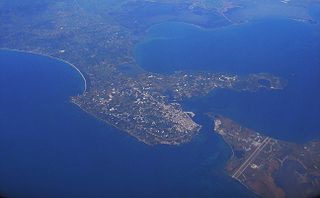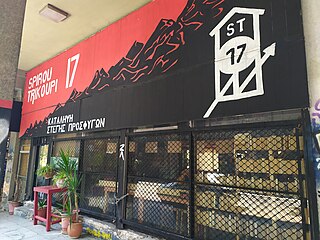Related Research Articles

Mytilene is the capital of the Greek island of Lesbos, and its port. It is also the capital and administrative center of the North Aegean Region, and hosts the headquarters of the University of the Aegean. It was founded in the 11th century BC.

Ioannina, often called Yannena within Greece, is the capital and largest city of the Ioannina regional unit and of Epirus, an administrative region in north-western Greece. According to the 2011 census, the city population was 65,574, while the municipality had 112,486 inhabitants. It lies at an elevation of approximately 500 metres above sea level, on the western shore of lake Pamvotis (Παμβώτις). Ioannina is located 410 km (255 mi) northwest of Athens, 260 kilometres southwest of Thessaloniki and 80 km east of the port of Igoumenitsa in the Ionian Sea.

Preveza is a city in the region of Epirus, northwestern Greece, located on the northern peninsula at the mouth of the Ambracian Gulf. It is the capital of the regional unit of Preveza, which is part of the region of Epirus. The Aktio-Preveza Immersed Tunnel – the first and so far only undersea tunnel in Greece – was completed in 2002 and connects Preveza in the north to Aktio in western Acarnania in Aetolia-Acarnania south of the mouth of the Ambracian Gulf. The ruins of the ancient city of Nicopolis lie 7 kilometres north of the city.

Cham Albanians or Chams, are a sub-group of Albanians who originally resided in the western part of the region of Epirus in Northwestern Greece, an area known among Albanians as Chameria. The Chams have their own particular cultural identity, which is a mixture of Albanian and Greek influences as well as many specifically Cham elements. A number of Chams contributed to the Albanian national identity and played an important role in starting the renaissance of the Albanian culture in the 19th century. The Chams speak their own dialect of the Albanian language, the Cham Albanian dialect, which is a Southern Tosk Albanian dialect and one of the two most conservative ones; the other being Arvanitika.

Konitsa is a town of Ioannina in Epirus, Greece. It is located north of the capital Ioannina and near the Albanian border. Northeast of Konitsa lies a group of villages known as the Zagorochoria. The town was built amphitheatrically-shaped on a mountain slope of the Pindos mountain range from where it overlooks the valley where the river Aoos meets the river Voidomatis.

Parga is a town and municipality located in the northwestern part of the regional unit of Preveza in Epirus, northwestern Greece. The seat of the municipality is the village Kanallaki. Parga lies on the Ionian coast between the cities of Preveza and Igoumenitsa. It is a resort town known for its natural environment.

Pogoniani is a village and a former community in the Ioannina regional unit, Epirus, Greece. Since the 2011 local government reform it is part of the municipality Pogoni, of which it is a municipal unit. The municipal unit has an area of 56.693 km2, the community 18.830 km2. The municipal unit consists of 4 villages: Pogoniani, Dolo, Drymades, Stavroskiadi.

Margariti is a village and a former municipality in Thesprotia, Epirus, Greece. Since the 2011 local government reform it is part of the municipality Igoumenitsa, of which it is a municipal unit. The municipal unit has an area of 149.223 km2. Population 2,491 (2011).

The Municipal Art Gallery of Ioannina is an art museum in Ioannina, Greece that has been open in its current building since 2000. The collection of over 500 items ranges from classical to modern paintings and sculptures.

Doxa Kranoula F.C. is a Greek football club, based in Kranoula, Ioannina.The colours of the team is orange, blue and white.

Katsikas is the largest village of the municipal unit Pamvotida, in the Ioannina regional unit, Epirus, northern Greece. Since the 2011 local government reform it is part of the municipality Ioannina. Its population is 3,885 (2011).

Zographeion College was a Greek educational institution that operated from 1873 to 1891 in the village of Qestorat, Ottoman Empire, in modern southern Albania. It was named after its sponsor Christakis Zografos. In the 18 years of its existence, it provided 400 teachers to the Greek schools of Epirus as well as to the rest of the Greek world.

Mousiotitsa or Kato Mousiotitsa is a village located in the Ioannina regional unit in the Epirus region of western Greece. Situated 33 km south of the city of Ioannina near the springs of the river Louros, the village consists of 4 areas: Kato Mousiotitsa, Ano Mousiotitsa, Nea Mousiotitsa and Mesoura. It is surrounded by 5 mountains: Bitera, Spithari, Pourizi, Kalogeritsa and Katafi.
Dryinopolis or Dryinoupolis is a historical region in southwestern Albania and northwestern Greece in Epirus. The heartland of this region is the valley of the Drino river and Dropull/Dropolis. A Greek-Orthodox bishopric under this name was established at 449 AD as well as a theme (district) of the Byzantine Empire and the Despotate of Epirus. Today the name of Dryinopolis is preserved in the local metropolitan bishopric of the Church of Greece for the Greek part of the region, while the Albanian part is under the religious jurisdiction of the metropolis of Gjirokaster of the Autocephalous Orthodox Church of Albania.

The 8th Infantry Division was an infantry division of the Hellenic Army.

The European migrant crisis, also known as the refugee crisis, was a period characterised by high numbers of people arriving in the European Union (EU) overseas from across the Mediterranean Sea or overland through Southeast Europe. In March 2019, the European Commission declared the migrant crisis to be at an end, although displaced people continued to arrive.

Kara Tepe is located about 2.5 km to the north of Mytilene, the capital of the island of Lesbos. The camp is managed by the Municipality of Mytilene and UNHCR in collaboration with the NGOs that operate there. The Site Manager is Mr. Michail Batzakis. The purpose of the camp is to provide temporary housing for asylum seekers as they await their registration processes. Kara Tepe was the overflow site for Moria Refugee Camp, the main registration center in Greece and Europes biggest refugee camp, known as a hotspot established by the Greek government through which new arrivals would be processed. Initially, refugees were mandated to spend a minimum of 25 days in the Moria camp before being transferred to Kara Tepe, however due to the overcrowding of the Moria camp, most stayed much longer.

Athens refugee squats exist since the 2015 spike in the European migrant crisis, Greece has been a destination for migrants seeking refuge on the European continent via the "Balkan Route." Coalitions of solidarity groups and migrants have established squats throughout Athens to house refugees, demonstrating an alternative to solutions offered by the European Union and NGOs. The squats are grouped together in the Coordination of Refugee Squats. Notable projects included 5th School and City Plaza. In late 2019, the New Democracy party declared it would evict all the squats.
The COVID-19 pandemic in Greece is part of the worldwide pandemic of coronavirus disease 2019 caused by severe acute respiratory syndrome coronavirus 2. The first case in Greece was confirmed on 26 February 2020 when a 38-year-old woman from Thessaloniki who had recently visited Νorthern Italy, was confirmed to be infected. Subsequent cases in late February and early March related to people who had travelled to Italy and a group of pilgrims who had travelled to Israel and Egypt, as well as their contacts. The first death from COVID-19 in Greece was a 66-year-old man, who died on 12 March. As of 8 February 2021, there have been 164575 confirmed cases and 5,997 deaths. Since the opening of the Greek borders to tourists at the end of June 2020, the daily number of confirmed cases announced has included those detected following tests at the country's entry points.
Mória Reception and Identification Centre, better known as Mória Refugee Camp, or just "Mória", was the largest refugee camp in Europe until it was burned down in September 2020. It was located outside the village of Moria near Mytilene on the island of Lesbos. Enclosed with barbed wire and a chain-link fence, the military camp served as a European Union “hotspot”. It was described by Human Rights Watch as an open air prison.
References
- ↑ "Δομές Φιλοξενίας-Προσωρινής Υποδοχής/Δομή Κατσικά Ιωαννίνων". Υπουργείο Μετανάστευσης και Ασύλου. Archived from the original on 2021-04-18.
- 1 2 "ASB Greece – ASB GREECE" (in Greek). Retrieved 2021-04-18.
- ↑ "Ο Δημήτρης Λάκκας διοικητής στη δομή του Κατσικά • EpirusPost • Ειδήσεις, Ιωάννινα, Άρτα, Πρέβεζα, Θεσπρωτία" (in Greek). Retrieved 2021-04-18.
- 1 2 "Αποκαταστάθηκε η ηρεμία στη δομή προσφύγων στον Κατσικά". EPIRUS Online (in Greek). 2020-12-16. Retrieved 2021-04-18.
- ↑ "Μαρτυρίες για δακρυγόνα και πυροβολισμούς από την ΕΛΑΣ σε κέντρο προσφύγων αλλά σιωπή". tvxs.gr. Retrieved 2021-04-18.